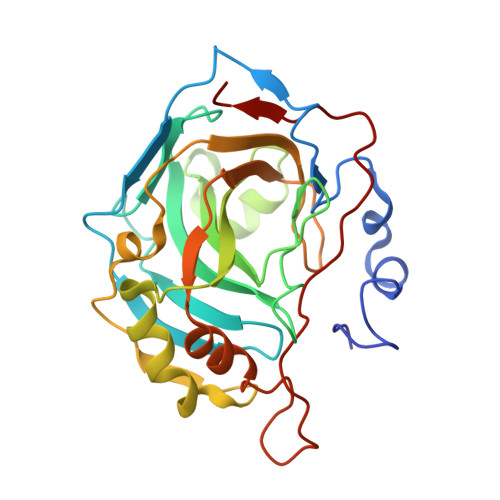Sulfonamido carboranes as highly selective inhibitors of cancer-specific carbonic anhydrase IX.
Dvoranova, J., Kugler, M., Holub, J., Sicha, V., Das, V., Nekvinda, J., El Anwar, S., Havranek, M., Pospisilova, K., Fabry, M., Kral, V., Medvedikova, M., Matejkova, S., Liskova, B., Gurska, S., Dzubak, P., Brynda, J., Hajduch, M., Gruner, B., Rezacova, P.(2020) Eur J Med Chem 200: 112460-112460
- PubMed: 32505851
- DOI: https://doi.org/10.1016/j.ejmech.2020.112460
- Primary Citation of Related Structures:
6T7U, 6T9Z - PubMed Abstract:
Carbonic anhydrase IX (CA IX) is a transmembrane enzyme overexpressed in hypoxic tumors, where it plays an important role in tumor progression. Specific CA IX inhibitors potentially could serve as anti-cancer drugs. We designed a series of sulfonamide inhibitors containing carborane clusters based on prior structural knowledge of carborane binding into the enzyme active site. Two types of carborane clusters, 12-vertex dicarba-closo-dodecaborane and 11-vertex 7,8-dicarba-nido-undecaborate (dicarbollide), were connected to a sulfonamide moiety via aliphatic linkers of varying lengths (1-4 carbon atoms; n = 1-4). In vitro testing of CA inhibitory potencies revealed that the optimal linker length for selective inhibition of CA IX was n = 3. A 1-sulfamidopropyl-1,2-dicarba-closo-dodecaborane (3) emerged as the strongest CA IX inhibitor from this series, with a K i value of 0.5 nM and roughly 1230-fold selectivity towards CA IX over CA II. X-ray studies of 3 yielded structural insights into their binding modes within the CA IX active site. Compound 3 exhibited moderate cytotoxicity against cancer cell lines and primary cell lines in 2D cultures. Cytotoxicity towards multicellular spheroids was also observed. Moreover, 3 significantly lowered the amount of CA IX on the cell surface both in 2D cultures and spheroids and facilitated penetration of doxorubicin. Although 3 had only a moderate effect on tumor size in mice, we observed favorable ADME properties and pharmacokinetics in mice, and preferential presence in brain over serum.
Organizational Affiliation:
Institute of Molecular and Translational Medicine, Olomouc, Hněvotínská 1333/5, 77900, Olomouc, Czech Republic; Cancer Research Czech Republic, Hněvotínská 5, 77900, Olomouc, Czech Republic.
















